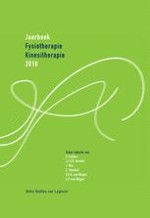Samenvatting
Er is een matige bewijskracht voor de effectiviteit van beenorthesen bij patiënten met een cerebrovasculair accident (CVA). Uit systematische reviews blijkt dat de loopsnelheid en de stap- en schredelengte kunnen verbeteren met het gebruik van een enkel-voetorthese (EVO). Er zijn echter nog veel vragen onbeantwoord met betrekking tot de werking en het juiste gebruik van EVO’s. In dit hoofdstuk wordt beschreven hoe er in de revalidatiepraktijk gebruik wordt gemaakt van een biomechanisch denkkader, om tot een adequate indicatie en verstrekking van een orthese te komen. Begrippen als kinematica en kinetica worden geïntroduceerd bij de beschrijving van normale en pathologische looppatronen. Aan de hand van deze kennis worden handvatten gegeven voor de praktijk waarmee gewenste en ongewenste werking van een orthese-schoencombinatie inzichtelijk gemaakt wordt.
